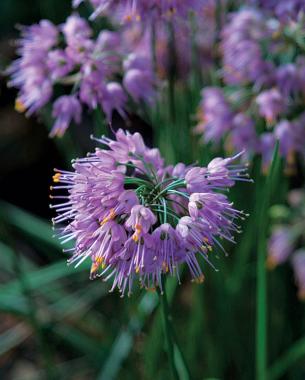
Photo/Illustration: Jennifer Brown
Many years ago, when I first spoke at a well-attended perennial conference, the person introducing me asked if someone had a box because I’m so “vertically challenged.” Short people always seem to be the butt of jokes and, in the words of the late comedian Rodney Dangerfield, “get no respect.” Not long after that conference, I recognized that short perennials were in the same boat. Large plants seem to get all the accolades. They’re often labeled as big, bodacious focal points and are celebrated for their superior architectural effects and textural features. The best that most gardeners have to say about plants for the front of the garden is that they’re short, diminutive, small-statured, or, heaven forbid, dwarf—a word that implies misshapen, which most edging perennials are anything but.
No garden is complete without low-growing plants, which beautifully accentuate bed lines, define path and bed boundaries, soften harsh edges, and counter large-scale plants for visual interest. To be worthy of being planted in my garden, perennial edgers have to work hard. They must flower for a long time, have interesting foliage color and texture from spring to fall, and show minimal disease and pest problems.
The ideal height of edging plants depends on how close you will be to the beds when viewing them. For beds that are viewed from a distance, 2-foot-tall plants work well. Of course, you can go taller than 2 feet if the plant is see-through (or airy enough to permit a view of the plants behind it). For beds that are observed up close, plants that are no more than 18 inches tall fit the bill. No matter where you view them from, the number of good candidates for sun and shade seems almost endless.
Pint-size plants for sun
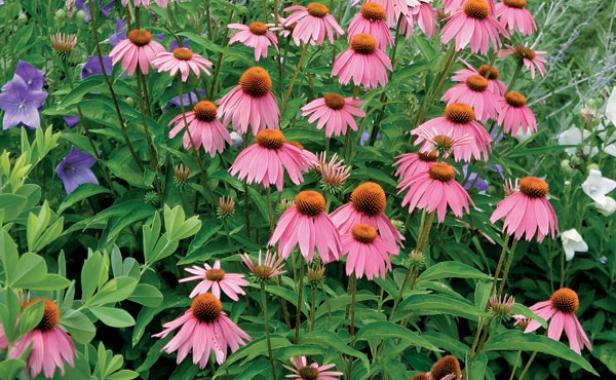
One of the simplest ways to tie a garden together is to use repetition. This can be done in a number of ways, such as by selecting plants with similar colors and forms. I like to use repetition by echoing traditional perennials with their shorter counterparts. Classic purple coneflowers (Echinacea purpurea and cvs., USDA Hardiness Zones 3–9) typically grow to 3 feet or taller and work well for this approach. While the compact cultivars are not lilliputian, they average 18 inches tall. The smallish ‘Kim’s Knee High’ flaunts typical purple-rose blooms, ‘Kim’s Mop Head’ produces white flowers, and ‘Little Giant’ has larger, purplish blooms with horizontal petals that are supported on 16-inch-tall stems.
All of these cultivars flower in summer and continue until frost with deadheading. They grow in full sun and average soil, and can handle summer heat without looking bedraggled. Their coarse, hairy leaves are rarely bothered by deer, but our four-legged foes often find the flowers palatable. Besides being excellent edgers, short purple coneflowers also attract butterflies and make superb cut flowers.
Another beloved plant with miniaturized sidekicks is the summer-blooming Shasta daisy (Leucanthemum × superbum cvs., Zones 5–8). My two favorite petite cultivars are ‘Snowcap’, a Blooms of Bressingham selection, and ‘Little Miss Muffet’, an older variety. ‘Little Miss Muffet’ is 12 inches tall, while ‘Snowcap’ reaches 15 inches tall. ‘Snowcap’ seems to bloom a few weeks longer, especially with deadheading, and is more tolerant of adverse weather conditions. Both of these single white cultivars require full sun and well-drained garden loam. A good use of flower repetition finds the stellar 3-foot-tall ‘Becky’ Shasta daisy a hop, skip, and a jump from ‘Snowcap’ or ‘Little Miss Muffet’.

Photo/Illustration: Michelle Gervais
Blanket flowers (Gaillardia × grandiflora cvs., Zones 3–8) and I used to mix like oil and water. They always seemed to develop urban sprawl by the time they reached full bloom, creating an ugly mess. Ever since the newer, shorter cultivars came out, however, blanket flowers are again welcome in my garden. Reaching 10 inches tall, the new plants do not flop, and their red-and-yellow blooms produce a riot of color from summer until frost. The selection ‘Arizona Sun’ has hypnotic flat red flowers edged in yellow. ‘Fanfare’ has a more unusual look with its fused, trumpet-like red petals with yellow tips. Like the rest of their kin, both plants are drought tolerant and have a long season of bloom, which can increase in abundance with deadheading. For those gardeners looking for something a little more subtle, ‘Summer’s Kiss’ is a dreamy selection that boasts blooms in shades of yellow-apricot.
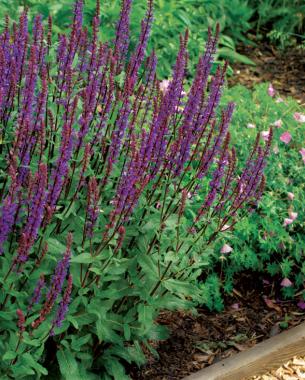
Photo/Illustration: Jennifer Benner
Salvia nemorosa ‘Marcus’ and ‘Caradonna’ are two sages that can easily be the stars of the late-spring border in Zones 5 to 9. ‘Marcus’ is a compact, 10-inch-tall plant that is covered with violet-blue flower spikes when in bloom. ‘Caradonna’ has beautiful dark violet spikes, which rise above dramatic deep purple, upright stems that look black when backlit. Even though ‘Caradonna’ is about 2 feet tall, its linear, see-through flowers make it a prime contender for the front of the border. Both ‘Marcus’ and ‘Caradonna’ require full sun, average garden soil, and good drainage. They’re blooming fools well into late summer, especially with deadheading.
For late-season interest, look to Allium thunbergii ‘Ozawa’ (Zones 4–8), which is commonly called the Japanese onion. At 9 to 12 inches tall, it has strappy, grasslike leaves in summer and bears star-shaped, violet-pink flowers in fall. It grows in almost any garden soil and is not browsed by deer. Because ‘Ozawa’ flowers late, I place it among plants that bloom earlier in the season to create a succession of color. Of course, there are many spring- and summer-blooming ornamental onions that are suitable for the front of the border. But beware—their foliage does yellow and disappear shortly after flowers fade.
More sun lovers
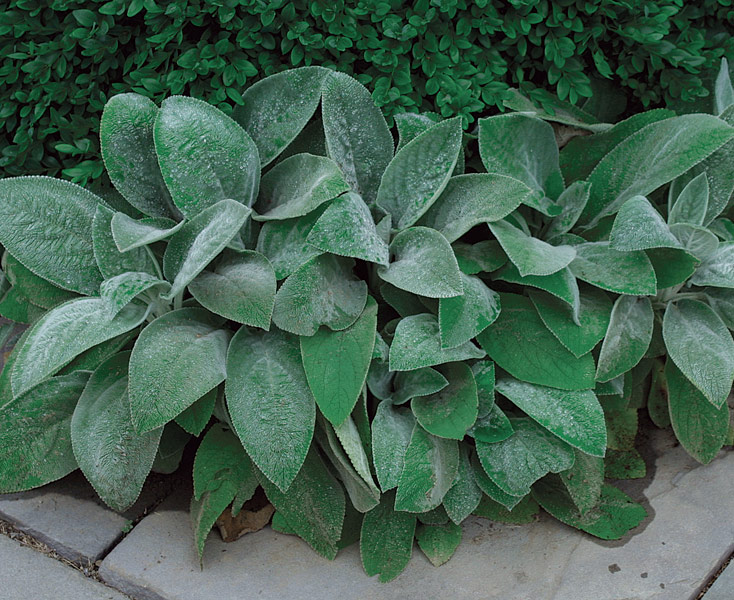
Photo/Illustration: Michelle Gervais
‘Angelina’ stonecrop (Sedum rupestre ‘Angelina’, Zones 6-9), 6 in.
‘Blue Ice’ bluestar (Amsonia ‘Blue Ice’, Z 4-9), 14 in.
‘Blue Star’ false aster (Kalimeris incisa ‘Blue Star’, Z 5-9), 15 in.
‘Caradonna’ sage (Salvia nemorosa ‘Caradonna’, Z 5-9), 24 in.
Catmints (Nepeta × faassenii cvs., Z 4-8), 12-24 in.
Clump verbena (Verbena ‘Homestead Purple’, Z 6-9), 10 in.
Dwarf cardinal flower (Lobelia × speciosa ‘Grape Knee-High’, Z 5-8), 22 in.
Dwarf fountain grass (Pennisetum alopecuroides ‘Hameln’, Z 6-9), 24 in.
Dwarf willow-leaved sunflower (Helianthus salicifolius ‘Low Down’, Z 6-9), 12 in.
‘Fanfare’ blanket flower (Gaillardia × grandiflora ‘Fanfare’, Z 3-8), 10 in.
‘Fire Witch’ pink (Dianthus ‘Fire Witch’, syn. D. ‘Feuerhexe’, Z 3-10), 6 in.
‘Golden Fleece’ goldenrod (Solidago sphacelata ‘Golden Fleece’, Z 5-9), 18 in.
Japanese onion (Allium thunbergii ‘Ozawa’, Z 4-8), 9-12 in.
‘Kim’s Knee High’ purple coneflower (Echinacea purpurea ‘Kim’s Knee High’, Z 3-9), 18 in.
Lambs’ ears (Stachys byzantina and cvs., Z 4-8), 12-18 in.
‘Lucerne’ blue-eyed grass (Sisyrinchium angustifolium ‘Lucerne’, Z 3-8), 12 in.
Plumbago (Ceratostigma plumbaginoides , Z 5-9), 18 in.
Prairie poppy mallow (Callirhoe involucrata , Z 4-9), 12 in.
‘Purple Dome’ aster (Aster novae-angliae ‘Purple Dome’, Z 4-8), 18 in.
‘Snowcap’ Shasta daisy (Leucanthemum × superbum ‘Snowcap’, Z 5-8), 15 in.
‘Stephanie Returns’ daylily (Hemerocallis ‘Stephanie Returns’, Z 3-8), 18 in.
Stokes’ asters (Stokesia laevis and cvs., Z 5-9), 12-24 in.
Petite perennials for shade

Photo/Illustration: courtesy of North Creek Nurseries
Sun-loving perennials aren’t the only ones with smallish counterparts; shady perennials have their fair share, too. One of the most notable is the dwarf wild columbine ‘Little Lanterns’ a shorter version of the 3-foot-tall native wild columbine (Aquilegia canadensis, Zones 3–8). At 12 to 18 inches tall, the midspring to midsummer blooms of ‘Little Lanterns’ are a more intense red and yellow than the species and sit atop red stems. Its compact habit makes it a good choice for formal shade gardens.
Like its predecessor, ‘Little Lanterns’ is an important food source for hummingbirds in early spring. It also tends to be deer resistant but not 100 percent deerproof. It’s ideally suited to partial to full shade; however, it can take full sun when it’s sited in moist soil. ‘Little Lanterns’ can suffer from leaf miner but to a lesser extent than other columbines. I usually just snip off the bad leaves or pretend I didn’t see them. If you can’t find ‘Little Lanterns’ and you stumble upon ‘Canyon Vista’, go for it. The two plants are pretty much identical.

Photo/Illustration: Jennifer Benner
Because many spring bloomers fade into nothing after flowering, it’s always refreshing to find ones that keep on going. There is a hybrid bleeding heart called ‘King of Hearts’ (Dicentra ‘King of Hearts’, Zones 5–9) that is well deserving of its name. In spring, it lights up the garden with dark rose flowers floating above lacy gray-green leaves. Unlike many other Dicentra species and cultivars, ‘King of Hearts’ is sterile and continues to flower into fall as long as it gets adequate moisture and well-drained garden loam.
In northern climates, site ‘King of Hearts’ in morning sun and afternoon shade. In southern regions, protect plants from heat and intense sun by placing them in light to medium shade. At 8 to 10 inches tall, ‘King of Hearts’ makes an excellent low-growing specimen at the edge of borders. There is also a white everblooming bleeding heart called Dicentra ‘Ivory Hearts’ (Zones 5–9), which grows to 12 inches tall.
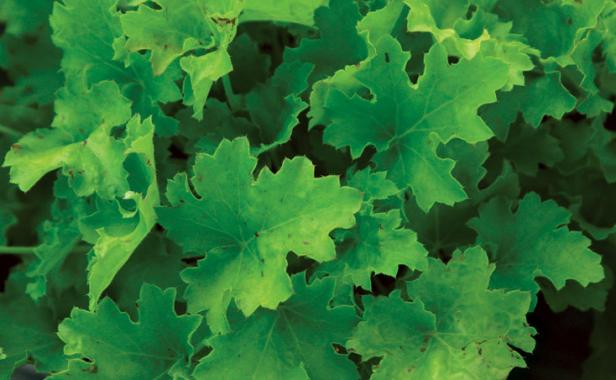
Photo/Illustration: Jennifer Benner
Unfortunately, most shade-loving perennials will not give us a lengthy season of bloom like the new bleeding hearts. So to get the most bang for my buck, I choose plants with attractive, long-lasting foliage texture and color. Heucheras (Heuchera spp. and cvs., Zones 3–8) are at the top of my list.
Also known as coral bells because of their pinkish white to coral blooms, this clan of perennials has a mounding habit that reaches 12 to 18 inches tall. Their most popular feature is their heart-shaped or rounded leaves with ruffled edges that come in a rainbow of colors from purple, green, metallic, and amber—purple being the most prevalent. Newer cultivars offer even more color options. ‘Lime Rickey’ (Zones 4–9), which sends up pure white flowers in spring, has wonderful chartreuse leaves that fade to lime green by midsummer. ‘Marmalade’ (Zones 4–9), another notable newbie, dazzles the eye with its dramatic umber to sienna leaves with hot pink undersides.
Heucheras need moisture-retentive, well-drained soil to thrive. In northern climates, they benefit from morning sun, but in the south, they do better in filtered to medium shade. From a design perspective, they work just about anywhere. They play nicely with other perennials, can hold their own in a massed planting, and are also happy in containers.
Bethlehem sage or lungwort (Pulmonaria spp. and cvs., Zones 2–8) is another perennial foliage favorite. Often used as an edger or low-growing focal point, it’s valued for its hairy, silver-spotted leaves that shimmer in the shade garden and are not browsed by deer. Lungwort’s trumpet-shaped flowers range from blue, white, or pink to deep raspberry, and last for a few weeks in spring. Garden-worthy selections include the 12-inch-tall ‘Victorian Brooch’, which has lovely magenta-coral blooms that grace its long silver leaves for up to two months, and the 8-inch-tall ‘Baby Blue’, whose flowers start out pink and mature to blue.
Lungworts need moist yet well-drained soil to stand up to the blazing days of summer. They are no stranger to powdery mildew in hot, humid climates, so it’s best to choose resistant varieties (like those mentioned here) and give plants some elbow room to promote air circulation. The leaves can be treated with a fungicide or removed once infected; however, because powdery mildew doesn’t kill the plants, my strategy is benign neglect. This affliction usually goes unnoticed because it’s camouflaged by the lungwort’s silvery leaves. This is particularly true of the 12-inch-tall cultivars ‘Silver Streamers’ and ‘Cotton Cool’, whose upright leaves are nearly pure silver.
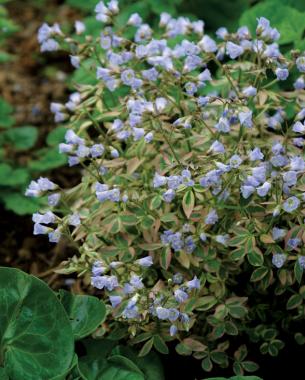
Photo/Illustration: Jennifer Benner
The last plant on the hit parade is a new cultivar, which comes to us from the New England Wild Flower Society, called variegated Jacob’s ladder (Polemonium reptans ‘Stairway to Heaven’, Zones 3–7). In early spring, the 15-inch-tall plant emerges with green leaves edged in white and tinged pink. Its pale blue flowers appear shortly after and dangle in drooping clusters. When the flowers begin to fade in early summer, so does the pink hue of the leaves, which makes the white margins seem more pronounced.
Unlike its popular close relative P. caeruleum, ‘Stairway to Heaven’ withstands heat and humidity as well as the cold. It requires moisture-retentive, well-drained soil. It thrives in filtered light or partial shade but will tolerate sunny spots as long as the soil remains moist. ‘Stairway to Heaven’ works well as a ground cover along walkways and paths. Pair it with other foliage plants that will accent and mirror its early pink tones and white variegation.
While there are many big, whopping perennials that get a lot of the glory, don’t forget that the little guys are important, too. No other plants can trim beds and borders or soften hard lines the way these gems can. With plenty to choose from for the sun or shade, vertically challenged perennials always get my respect.
More shade lovers

Photo/Illustration: Steve Aitken
Astilbes (Astilbe spp. and cvs., Z 3-8), 12-24 in.
Autumn fern (Dryopteris erythrosora, Z 5-9), 24 in.
‘Baby Blue’ lungwort (Pulmonaria ‘Baby Blue’, Z 2-8), 8 in.
Brunneras (Brunnera macrophylla and cvs., Z 3-7), 15-18 in.
Cranesbills (Geranium spp. and cvs., Z 4-8), 6-30 in.
Deadnettles (Lamium spp. and cvs., Z 4-8), 8-24 in.
Dwarf Solomon’s seal (Polygonatum humile , Z 5-8), 8 in.
Dwarf wild columbine (Aquilegia canadensis ‘Little Lanterns’, Z 3-8), 12-18 in.
European wild ginger (Asarum europaeum , Z 4-8), 3-6 in.
Foam flowers (Tiarella spp. and cvs., Z 3-9), 4-24 in.
Goatsbeard (Aruncus aethusifolius , Z 3-9), 12 in.
Hardy begonia (Begonia grandis ssp. evansiana, Z 6-9), 24 in.
Heucherellas (× Heucherella cvs., Z 5-8), 16-24 in.
Japanese forest grasses (Hakonechloa macra cvs., Z 6-9), 20 in.
‘King of Hearts’ bleeding heart (Dicentra ‘King of Hearts’, Z 5-9), 8-10 in.
‘Lime Rickey’ heuchera (Heuchera ‘Lime Rickey’, Z 4-9), 12-18 in.
Pigsqueaks (Bergenia spp. and cvs., Z 3-9), 12-24 in.
Sedges (Carex spp. and cvs., Z 3-9), 2-30 in.
Snowdrop anemones (Anemone sylvestris and cvs., Z 3-9), 18 in.
Toad lilies (Tricyrtis formosana and cvs., Z 6-9), 24 in.
Variegated Jacob’s ladder (Polemonium reptans ‘Stairway to Heaven’, Z 3-7), 15 in.
Wild stonecrop (Sedum ternatum, Z 4-8, 6 in.

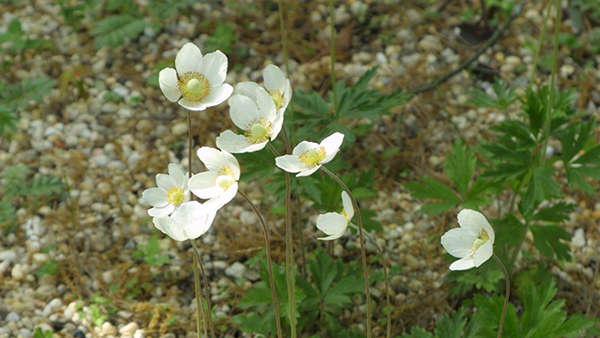
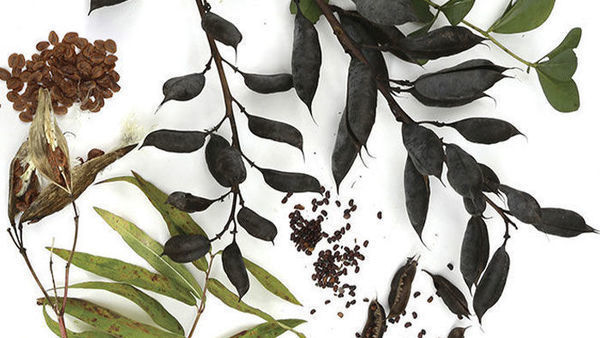
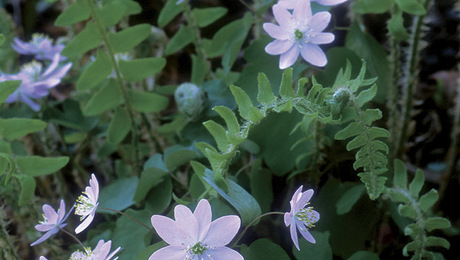
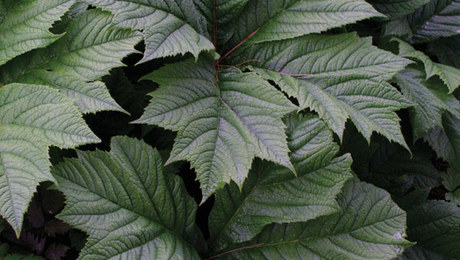












Comments
What if you NEVER get any rain? Gardening this summer in Durham has been sooooooooooooo depressing! NO rain, ever! Well, maybe twice. But it has been not enough, and has required so much watering. There has been even less rain than there was last summer. I can't bear to look outdoors at the shrubs hanging with green rags. And do not say "cactus" because I hate cactus in my garden.
I feel you... In NW Arkansas we have same problem. Drought or floods.
I know it has been some time since you've written this article, but I have just stumbled across it and really appreciate your thoughts. I especially like the way you have described the echoing juxtaposition of Lilliputian versions of larger border plants. It's very clever! In fact, your article is one of the reasons I just subscribed to Fine Gardening.
Log in or create an account to post a comment.
Sign up Log in